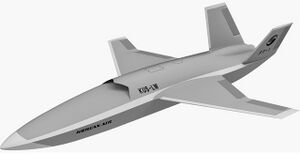KMAQ-2 'Kingfisher' Unmanned Combat Aerial Vehicle: Difference between revisions
| (3 intermediate revisions by the same user not shown) | |||
| Line 39: | Line 39: | ||
EOTS guides the missile to the target by identifying the exact location of the stealth target identified by the AESA radar. The EOTS also enables the management system to detect the location, appearance, type, and number of ground targets from a long distance. | EOTS guides the missile to the target by identifying the exact location of the stealth target identified by the AESA radar. The EOTS also enables the management system to detect the location, appearance, type, and number of ground targets from a long distance. | ||
===Protection=== | |||
KMAQ-2 has military-grade protection against non-nuclear and nuclear shock wave EMPs. | |||
==Operators== | ==Operators== | ||
{{flag|Joseon}} | * {{flag|Joseon}} | ||
* | ** {{Armed forces|Joseon}} | ||
* | *** {{air force|Joseon}} | ||
* Haeseo National Guard | *** {{naval|Joseon}} | ||
** Haeseo National Guard | |||
==Specifications== | ==Specifications== | ||
| Line 60: | Line 65: | ||
* Maximum speed: Mach 0.95 at altitude of 40,000 ft (12,000 m); Mach 0.85 at 200–500 ft (61–152 m) | * Maximum speed: Mach 0.95 at altitude of 40,000 ft (12,000 m); Mach 0.85 at 200–500 ft (61–152 m) | ||
* Combat range: 4,052 km | * Combat range: 4,052 km | ||
* Service ceiling: 20,000 m | * Service ceiling: 20,000 m | ||
Latest revision as of 06:14, 28 August 2024
| KMAQ-2 Kingfisher | |
|---|---|

| |
| Role | Unmanned combat aerial vehicle |
| National origin | |
| Manufacturer | Korean Air Lines Co., Ltd. |
| First flight | 19 August 2017 |
| Introduction | 1 May 2020 |
| Status | In service |
| Primary users | Royal Joseon Armed Forces |
KMAQ-2 'Kingfisher' is Unmanned Combat Aerial Vehicles operated by Royal Joseon Air Force and Royal Joseon Navy. KMAQ-2 made its first flight in 2017 and began deploying to the Air Force in 2020, and was designed to operate on ground runways and CATOBAR aircraft carriers.
Development
Design
Artificial intelligence
KMAQ-2 has robust and reliable self-management and self-flight capabilities through advanced algorithms running on high-performance processors. The management system has full control over the aircraft in a variety of situations, including aircraft condition monitoring and error detection, fuel condition monitoring, maximum g loads management, take-off and landing, flight control, waypoint navigation, aerial rendezvous, squadron flight, aerial refueling, and combat flight. Management systems can also operate in conjunction with manned or other unmanned aerial vehicles, requiring little human intervention. If communication with human commanders is not smooth due to enemy electronic warfare, management systems control aircraft to complete pre-populated tasks, eliminate immediate threats, and return to base.
The management system is powered by powerful, highly autonomous AI. These features are backed by algorithms such as self-defense and air combat algorithm.
Avionics
KMAQ-2 identifies targets through sensors, such as the AESA radar and EOTS. The AESA radar detects the exact location of non-stealth targets and detects the approximate location of stealth targets. The AESA radar can also perform electronic warfare, which jams enemy radars and missiles.
EOTS guides the missile to the target by identifying the exact location of the stealth target identified by the AESA radar. The EOTS also enables the management system to detect the location, appearance, type, and number of ground targets from a long distance.
Protection
KMAQ-2 has military-grade protection against non-nuclear and nuclear shock wave EMPs.
Operators
Joseon
Royal Joseon Armed Forces
- Haeseo National Guard
Specifications
General characteristics
- Crew: 0 (1 Remote Control Pilot)
- Length: 10.6 m
- Wingspan: 8.4 m
- Armed Capacity: 5,401 kg
- Powerplant: 1 × Hanwha Aerospace JT-301 turbofan engine, 8,000 lbf thrust, 12,780 lbf with afterburner
Performance
- Maximum speed: Mach 0.95 at altitude of 40,000 ft (12,000 m); Mach 0.85 at 200–500 ft (61–152 m)
- Combat range: 4,052 km
- Service ceiling: 20,000 m
- Gravity acceleration limit: 10 G
Armament
2 internal bomb bays, 1,580 kg of each bay. Can carry one of the following combinations.
- Missiles
- 4 x NMM-100 Anti-Ship cruise missile
- 2 x NGAM Anti-ship supersonic cruise missile
- 2 x Hyeon Mu-6 Hypersonic cruise missile
- 2 x Hyeon Mu-6B Air-to-Ground hypersonic cruise missile
- 2 x ASM-1100K Hypersonic anti-ship cruise missile
- 2 x AGM-158 Joint Air to Surface Standoff Missile (JASSM)
- 2 x AGM-158C Long Range Anti-Ship Missile (LRASM)
- 2 x KEPD 350 Taurus Air-launched cruise missile
- 2 x Cheonryong Air-launched cruise missile
- 2 x ADM-160 MALD Air-launched Active Radar Decoy
- 4 x AIM-120C/D AMRAAM
- 4 x KAIM-3 Cheonjeon 3
- Bombs
- 2 x Mk-82 air inflatable retarder (AIR) general purpose (GP) bombs
- 2 x Mk-82 low drag general purpose (LDGP) bombs
- 2 x Mk-62 Quickstrike sea mines
- 2 x Mk-84 general-purpose bombs
- 2 x Mk-65 naval mines
- 2 x CBU-87/89/CBU-97 Cluster Bomb Units (CBU)
- 2 x CBU-103/104/105 Wind Corrected Munitions Dispenser (WCMD) CBUs
- 2 x GBU-31 JDAM GPS guided bombs (Mk-84 GP or BLU-109 warhead)
- 2 x GBU-38 JDAM GPS guided bombs (Mk-82 GP warhead)
- 2 x GBU-54 LaserJDAM (using rotary launcher mounted multiple ejector racks)
- 6 x GBU-39 Small Diameter Bomb GPS guided bombs
Avionics
- AN/APG-83 AESA Radar
- AN/ALQ-161 radar warning receiver and defensive jamming equipment
- AN/ALR-94 RWR
- AN/AAQ-40 EOTS (Electro-Optical Targeting System)